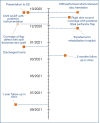Traumatic intradural disc herniation following a cervical facet dislocation: a case report
- PMID: 35441104
- PMCID: PMC8990393
- DOI: 10.21037/jss-21-106
Traumatic intradural disc herniation following a cervical facet dislocation: a case report
Abstract
We report a unique case of a patient who sustained an intradural disc herniation from a left C5-6 unilateral facet dislocation after a fall. This was not easily identified on pre-operative imaging. We explain the details of our surgical approach in this case report. A 65-year-old male fell into a 2 m drain and sustained a left C5/6 unilateral facet dislocation. He then sustained an American Spinal Injury Association (ASIA) B cord injury. His power was 0/5 from C8 downwards bilaterally but sensation was intact throughout. Magnetic resonance imaging (MRI) showed severe compression at C5/6 but no overt intradural disc herniation. This patient subsequently underwent a closed reduction in the operating theatre followed by a combined anterior and posterior approach for the disc herniation. Cerebral spinal fluid (CSF) leakage was noted upon completion of the C5/6 discectomy and it was discovered that there was a traumatic dural tear from the traumatic disc herniation. The decision was made not to repair the dural tear due to the friable nature of the dura and the potential for adhesive glue to propagate through the spinal cord. An anterior drain was placed for 3 days and then removed, he subsequently underwent rehabilitation and was able to regain power in the affected myotomes. Intradural disc herniations can be easily missed on MRI in the setting of cervical spinal trauma. Hence, the anterior approach is an increasingly acceptable approach to tackle disc herniations in unilateral cervical facet dislocations (CFD) surgery.
Keywords: Cervical facet dislocations (CFD); anterior approach; case report; intradural disc herniation; posterior approach.
2022 Journal of Spine Surgery. All rights reserved.
Conflict of interest statement
Conflicts of Interest: Both authors have completed the ICMJE uniform disclosure form (available at https://jss.amegroups.com/article/view/10.21037/jss-21-106/coif). The authors have no conflicts of interest to declare.
Figures





Similar articles
-
Complete cervical intervertebral disc extrusion with spinal cord injury in the absence of facet dislocation: a case report.Spine (Phila Pa 1976). 2004 May 1;29(9):E181-4. doi: 10.1097/00007632-200405010-00021. Spine (Phila Pa 1976). 2004. PMID: 15105683
-
Anterior decompression and nonstructural bone grafting and posterior fixation for cervical facet dislocation with traumatic disc herniation.Spine (Phila Pa 1976). 2012 Dec 1;37(25):2082-8. doi: 10.1097/BRS.0b013e31825ee846. Spine (Phila Pa 1976). 2012. PMID: 22614801
-
A single-stage posterior approach with open reduction and pedicle screw fixation in subaxial cervical facet dislocations.J Neurosurg Spine. 2015 Jul;23(1):35-41. doi: 10.3171/2014.11.SPINE14805. Epub 2015 Apr 24. J Neurosurg Spine. 2015. PMID: 25909272
-
Cervical Intradural Disc Herniation Causing Progressive Quadriparesis After Spinal Manipulation Therapy: A Case Report and Literature Review.Medicine (Baltimore). 2016 Feb;95(6):e2797. doi: 10.1097/MD.0000000000002797. Medicine (Baltimore). 2016. PMID: 26871842 Free PMC article. Review.
-
Intradural cervical disc herniation and Brown-Séquard's syndrome. Report of three cases and review of the literature.J Neurosurg. 2000 Apr;92(2 Suppl):236-40. doi: 10.3171/spi.2000.92.2.0236. J Neurosurg. 2000. PMID: 10763701 Review.
Cited by
-
Intradural Disk Herniation at the Conus Medullaris: A Case Report With Emphasis on Patient Positioning and Neuromonitoring.JBJS Case Connect. 2024 Nov 22;14(4):e24.00235. doi: 10.2106/JBJS.CC.24.00235. eCollection 2024 Oct 1. JBJS Case Connect. 2024. PMID: 39841040 Free PMC article.
References
Publication types
LinkOut - more resources
Full Text Sources
Research Materials
Miscellaneous
